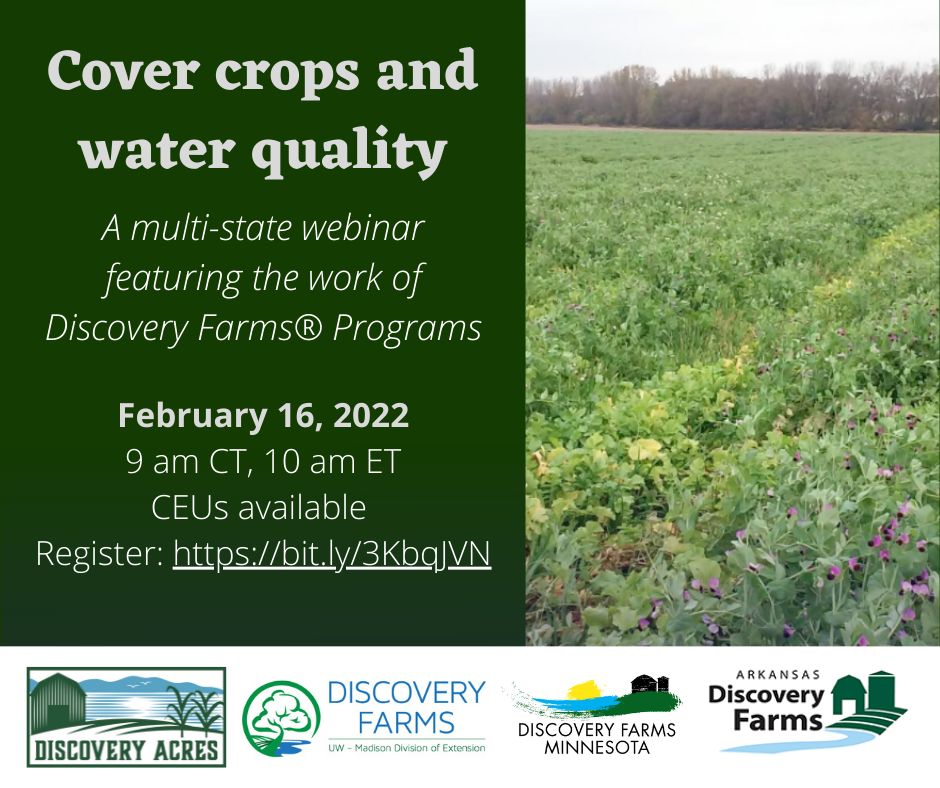On February 16, 2022, the Discovery Farms® Programs in Wisconsin, Vermont, Arkansas, and Minnesota will host a one-day webinar titled “Cover crops and water quality.” Join this interactive webinar to learn more from what water quality monitoring across these four states has shown on fields with planted cover crops.
This 3-hour webinar will begin at 9:00 am Central Time and 10:00 am Eastern Time. CEUs will be available. Please register for this free webinar at: https://bit.ly/3KbqJVN
The Discovery Farms® Program was founded in Wisconsin in 2001 with the task to partner with farmers to collect on-farm water quality data around the state and extend that information so that others could understand the impact of practices, and, if needed, adapt and adopt specific solutions to water quality challenges. Discovery Farms Programs are active in Wisconsin, Minnesota, Vermont and Arkansas. Each Discovery Farms Program is built on three pillars including:
Farmer leadership
On-Farm, water quality research
Communication of results
Read on for part two of an article series that will preview presentations to be given during the webinar on February 16, 2022.
Discovery Acres in Vermont
In Vermont, dairy production is the predominant agricultural industry. Hence it makes sense that perennial forage and corn silage are the predominant crops in the landscape. Agricultural production in Vermont is concentrated in the Lake Champlain Basin, which spans more than 8,000 sq. miles of land in Vermont, New York, and Quebec. In response to water quality concerns, the US EPA established a Total Maximum Daily Load (TMDL), for phosphorus (P) in the different segments of Lake Champlain. Overall phosphorus reductions are required to meet the total P criterion, or annual mean, set by the EPA for the Vermont segments of Lake Champlain. To improve water quality in Vermont, the VT Agency of Agriculture, Food and Markets, developed the Required Agricultural Practices (RAPs). This includes standards and requirements that all farm types must follow to reduce the impact of agricultural activities on water quality. These water quality concerns and regulations provide a challenge as well as an opportunity for Vermont farmers to adopt conservation practices. Farmers are implementing practices such as no-till, reduced tillage, and cover cropping to reduce runoff, improve soil structure, and reduce the amount of bare ground on their farms. But these practices can be challenging to adopt because of cost, access to equipment, environmental factors, or other management constraints. Climate models predict that the average annual precipitation will continue to increase in the Northeast, so it is critical to find management strategies that will minimize erosion and prevent nutrient runoff.
The Discovery Acres research site was established in 2020 by the University of Vermont Extension. Site selection for Discovery Acres was very important as it had to be representative of farms in the region. It is housed on an active dairy operation owned by the Bessette Family, with soil types (Covington clay) characteristic of the area. The poorly drained, heavy clay soils often require system tile to improve drainage. The research site is in the St Albans Bay which is categorized as an impaired watershed and is one of the segments of the Lake Champlain Basin that is a high priority for phosphorus reductions. Nutrient runoff from agricultural fields, in conjunction with elevated P levels in the sediment that is being released into the water column have led to high P levels and eutrophic conditions in the St Albans Bay. Reductions in nutrient runoff must be addressed first to limit P entering the lake via surface waters before efforts can begin on reducing P levels in the sediment. An overall reduction of 24.5% is required to meet the TMDL set by the US EPA.
An advisory board, consisting of farmers and agency representatives, worked in collaboration with the project team to develop the research design and treatments that would be implemented at Discovery Acres. The experimental design of Discovery Acres is a paired watershed design with edge-of-field (EoF) monitoring devices and four micro-watersheds. Two of the micro-watersheds each have a surface EoF device on non-tile drained land. The other two micro-watersheds each have a surface and sub-surface EoF device on land with tile drainage. The objective of this project is to compare conventional management to best management practices on land with and without tile drainage to understand the impact that those practices have on water quality, soil health, and crop production. Farmers in Vermont are specifically interested in cover crop termination and manure management techniques. Currently calibration data is being collected to monitor tile flow, surface runoff, and nutrient levels to understand the natural differences in each of the micro-watershed prior to treatment implementation, which is scheduled to begin in 2023.
One of the key aspects of Discovery Acres is outreach, not only to farmers and policy makers, but also to the general public. UVM Extension will use this site to inform the public about the impact that conservation practices can have on the health of agricultural soils and water quality in the Lake Champlain Basin. With the use of edge-of-field monitoring devices, farmers will be able to see the impact that different management strategies have on their crops as well as the movement of nutrients and soil from their fields. Many farmers in Vermont are implementing a variety of conservation practices on their land already but lack the data to verify that those practices are accomplishing the goals they set out to accomplish.
Join us on February 16 as we dive deeper into this discussion on cover crops and water quality.

- Cover crops and water quality webinar preview #2 - February 11, 2022